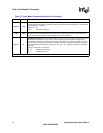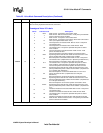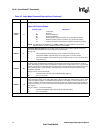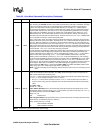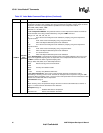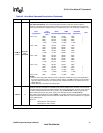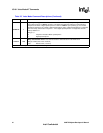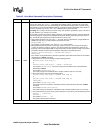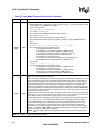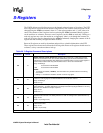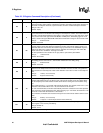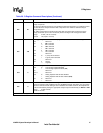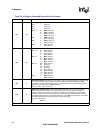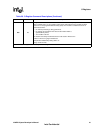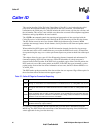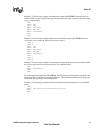
84 536EX Chipset Developer’s Manual
Intel Confidential
IS-101 Voice Mode AT Commands
+VTS=m
(cont.)
none
DTMF and Tone Generation: (cont.)
3. Single DTMF tones or hook flashes are sent enclosed in braces “{ }”. A duration must be included,
as the duration set in +VTD=m does not apply.
Use the following format:
AT+VTS={<DTMF or !>,<duration>}
For example: AT+VTS={2,30}
This command sends DTMF tone 2 with a duration of 300 ms.
For example: AT+VTS={!,50}
This command sends a hook flash with a duration of 500 ms.
Send multiple DTMF signals and tones by combining elements in a given +VTS=m command
string.
For example:
AT+VTS={!,30}, 1, 2, [1000,1300,50], !, {*,6}, [1000], 9
This command line programs the following events:
1. Hook-flash with a duration of 300 ms.
2. Send DTMF 1 for the duration specified by +VTD command.
3. Send DTMF 2 for the duration specified by +VTD command.
4. Send tone pair 1000 Hz and 1300 Hz for a duration of 500 ms.
5. Hook-flash with a duration specified by +VTD command.
6. Send DTMF * for a duration of 60 ms.
7. Send tone 1000 Hz for a duration specified by the +VTD command.
8. Send DTMF 9 for the duration specified by +VTD command.
For example:
AT+VTS=1, [, ,50], 2, [ ], 9
This command line programs the following events:
1. Send DTMF 1 for the duration specified by +VTD command.
2. Play silence for a duration of 500 ms.
3. Send DTMF 2 for the duration specified by +VTD command.
4. Play silence for a duration specified by +VTD command.
5. Send DTMF 9 for the duration specified by +VTD command.
+VTX none
Play Mode: This command causes the modem to start voice transmission (playback mode) and play
back a previously recorded voice message.
Upon receiving the AT+VTX command, the modem responds to the DTE with a ‘CONNECT’ message
at the current DTE-to-modem rate. It is important that the UARTs DTE-to-modem rate be equal to or
higher than the compression-scheme-required UART data rate (for example, CL1 at 4800 samples/
second requires 57,600 bps). If the DTE-to-modem data rate is lower than the compression-scheme-
required UART data rate, then data may be lost or the playback message may be garbled. After
receiving the ‘CONNECT’ message, the DTE then sends the voice file to the modem. To ensure that
data is not overwritten, the modem provides both hardware or software flow control with AT+FLO=m.
The modem also buffers the data to ensure steady voice delivery, even though the voice data may be
transferred from the DTE in bursts.
Playing mode is terminated when the data is exhausted and the modem receives the two terminating
characters <DLE><ETX> from the DTE. Upon detecting <DLE><ETX>, the modem issues an ‘OK’ result
code. After the modem’s internal buffer is empty, it returns to the command mode.
To abort playback mode immediately without waiting for the modem to empty its internal buffer, send
<DLE><CAN><DLE><ETX>.The modem aborts playback mode immediately in two other situations:
during a AT+VIT=m time-out or a DTR toggle. The modem immediately aborts playback mode if
+VIT≠0 and the modem has not received any data or if the modem receives a <DLE><NUL> code
before the +VIT timer time-out. The modem then hangs up the line and switches to data mode
(+FCLASS=0). If the UART DTR signal is toggled from on-off-on, then the modem follows the &Dn
setting. If configured for &D2 or &D3, then the modem immediately aborts playback mode, hangs up
the line, and switches to data mode (+FCLASS=0).
NOTE: The voice sampling rate and sampling mode must be the same values used during record
mode.
Table 25. Voice Mode Command Descriptions (Continued)
Command Default Description
NOTE: An asterisk (*) denotes the factory-default setting.



